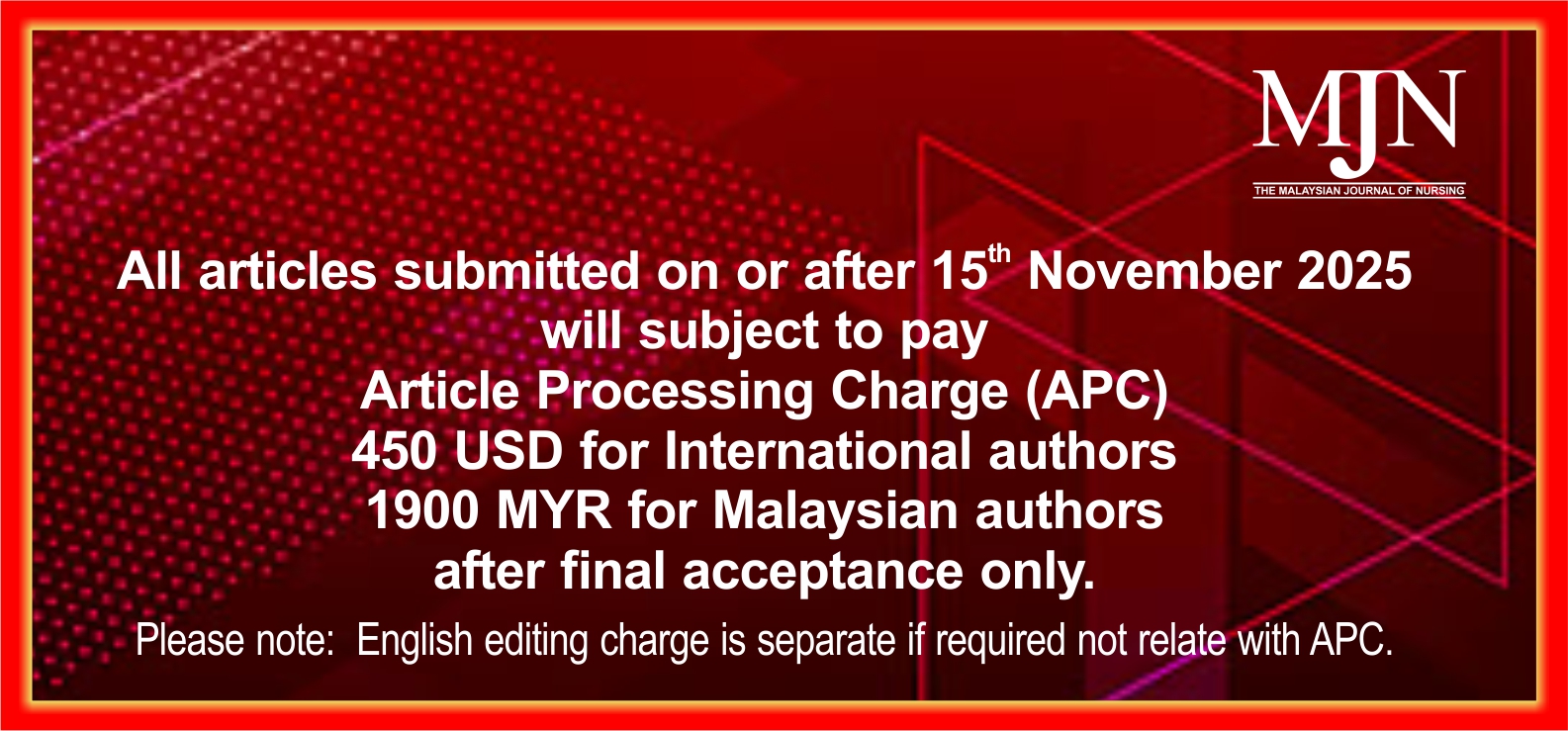Medication Calculations Competency among Nurses: A Cross-sectional Study
DOI:
https://doi.org/10.31674/mjn.2024.v16i02.014Abstract
Background: Medication calculation, dispensing, and administration are one of the major tasks of nurses, and medication errors (MEs) are one of the most common errors in the medical field, where some of these errors are fatal. ME can be attributed to many causes, such as medication dosage calculation errors. Accordingly, this study aims to assess Jordanian nurses` competency regarding medication calculation and its associated factors. Methods: A descriptive cross-sectional study design was used to assess the medication calculation skills of 126 registered nurses in Jordan, representing different departments of three governmental hospitals. Nurses’ dosage calculation skills were evaluated using a self-administered Nursing Medication Calculation Competency Tool (NMCCT) prepared by eXperts in nursing practice assessing nurses’ medication calculation competency in oral, parenteral, and intravenous flow rate. Data was collected; data entry was done on a Microsoft Office EXcel sheet and analysed using SPSS 25.0. Results: The study found that 95% of nurses (n = 120) did not receive mathematical education during their nursing program, and 84.9% (n = 107) reported no medication calculation competency programs at their hospitals. Additionally, 79.7% (n = 113) had not attended any such courses post-graduation, and 90.5% reported a lack of medication administration guidelines at their hospitals. Competency was highest for oral medication calculations (65.1%), followed by intravenous flow rates (57.9%) and parenteral/intravenous medications (48.9%). Only 27.8% (n = 35) were competent in all three areas. Significant factors affecting competency were nurse age, availability of programs, and post-graduation courses (p = 0.045, <0.001). Conclusion: Nursing curricula and continuing education programs should recognize pharmaceutical education, including drug calculation skills, as an essential part of their content. Also, the researchers encourage the adoption of a national-wide learning/competency program that is able to assess the level of competency, track gaps in medication calculation skills, and provide a supportive learning program in this aspect as needed.
Keywords:
Medication Errors, Medication Calculations, Nursing Competency, Nursing Education, Nursing SkillsDownloads
References
Al-Qaaneh, A. M., & Al-Ghamdi, F. H. (2021). Tocilizumab prescribing criteria for COVID-19 patients. Hum Vaccin Immunother, 17(4). https://doi.org/10.1080/21645515.2020.1822137
Al-Qaaneh, A. M., Al-Ghamdi, F. H., AbdulAzeez, S., & Borgio, J. F. (2022a). Safety of tocilizumab in covid-19 patients and benefit of single-dose: the largest retrospective observational study. Pharmaceutics, 14(3). https://doi.org/10.3390/pharmaceutics14030624
Al-Qaaneh, A. M., Obaid, W. T., Al-Mohammadi, O. S., Al-Qaaneh, A. M., Rabaan, A. A., & Mustafa, S. M. (2022b). Dose-dependent atorvastatin associated with angioedema. International Journal of Clinical Pharmacology and Therapeutics, 60(2), 106-110. https://doi.org/10.5414/cp204025
Al-Sayedahmed, H., Al-Qaaneh, A., Al-Tawfiq, J., Al-Dossary, B., & Al-Yami, S. (2023). Perception of health care professionals toward hospital accreditation at johns hopkins aramco healthcare. Qual Manag Health Care, 32(4), 238-246. https://doi.org/10.1097/qmh.0000000000000405
Alrabadi, N., Haddad, R., Haddad, R., Shawagfeh, S., Mukatash, T., Al-rabadi, D., & Abuhammad, S. (2020). Medication errors among registered nurses in Jordan. Journal of Pharmaceutical Health Services Research, 11(3), 237-243. https://doi.org/https://doi.org/10.1111/jphs.12348
Aronson, J. K. (2009). Medication errors: What they are, how they happen, and how to avoid them. Qjm, 102(8), 513-521. https://doi.org/10.1093/qjmed/hcp052
Breuker, C., Macioce, V., Mura, T., Castet-Nicolas, A., Audurier, Y., Boegner, C., Jalabert, A., Villiet, M., Avignon, A., & Sultan, A. (2021). Medication errors at hospital admission and discharge: Risk factors and impact of medication reconciliation process to improve healthcare. Journal of Patient Safety, 17(7), e645-e652. https://doi.org/10.1097/pts.0000000000000420
Cousins, D. H., Sabatier, B., Begue, D., Schmitt, C., & Hoppe-Tichy, T. (2005). Medication errors in intravenous drug preparation and administration: A multicentre audit in the UK, Germany and France. Qual Saf Health Care, 14(3), 190-195. https://doi.org/10.1136/qshc.2003.006676
Dilles, T., Vander Stichele, R. R., Van Bortel, L., & Elseviers, M. M. (2011). Nursing students' pharmacological knowledge and calculation skills: Ready for practice? Nurse Education Today, 31(5), 499-505. https://doi.org/10.1016/j.nedt.2010.08.009
Elliott, M., & Joyce, J. (2005). Mapping drug calculation skills in an undergraduate nursing curriculum. Nurse Education in Practice, 5(4), 225-229. https://doi.org/10.1016/j.nepr.2004.12.003
Elliott, R. A., Camacho, E., Jankovic, D., Sculpher, M. J., & Faria, R. (2021). Economic analysis of the prevalence and clinical and economic burden of medication error in England. BMJ Quality & Safety, 30(2), 96-105. https://doi.org/10.1136/bmjqs-2019-010206
Fleming, S., Brady, A. M., & Malone, A. M. (2014). An evaluation of the drug calculation skills of registered nurses. Nurse Education in Practice, 14(1), 55-61. https://doi.org/10.1016/j.nepr.2013.06.002
Gage, C. B., & Preuss, C. V. (2024). Dose Calculation. StatPearls Publishing LLC. USA.
Grandell-Niemi, H., Hupli, M., Leino-Kilpi, H., & Puukka, P. (2005). Finnish nurses' and nursing students' pharmacological skills. Journal of Clinical Nursing, 14(6), 685-694. https://doi.org/10.1111/j.1365-2702.2005.01131.X
Han, P. Y., Coombes, I. D., & Green, B. (2005). Factors predictive of intravenous fluid administration errors in Australian surgical care wards. BMJ Quality & Safety, 14(3), 179-184. https://doi.org/10.1136/qshc.2004.010728
Hodkinson, A., Tyler, N., Ashcroft, D. M., Keers, R. N., Khan, K., Phipps, D., Abuzour, A., Bower, P., Avery, A., Campbell, S., & Panagioti, M. (2020). Preventable medication harm across health care settings: a systematic review and meta-analysis. BMC Medicine, 18(1). https://doi.org/10.1186/s12916-020-01774-9
Keers, R. N., Williams, S. D., Cooke, J., & Ashcroft, D. M. (2013). Causes of medication administration errors in hospitals: a systematic review of quantitative and qualitative evidence. Drug Safety, 36(11), 1045-1067. https://doi.org/10.1007/s40264-013-0090-2
Koohestani, H., & Baghcheghi, N. (2010). Comparing the effects of two educational methods of intravenous drug rate calculations on rapid and sustained learning of nursing students: Formula method and dimensional analysis method. Nurse Education in Practice, 10(4), 233-237. https://doi.org/10.1016/j.nepr.2009.11.011
Linden-Lahti, C., Takala, A., Holmström, A. R., & Airaksinen, M. (2021). What severe medication errors reported to health care supervisory authority tell about medication safety? Journal of Patient Safety, 17(8), e1179-e1185. https://doi.org/10.1097/pts.0000000000000914
Lu, Y., Green, A. R., Quiles, R., & Taylor, C. O. (2023). An automated strategy to calculate medication regimen compleXity. AMIA Annual Symposium Proceedings, 2023, 1077-1086. https://www.ncbi.nlm.nih.gov/pmc/articles/PMC10785893/pdf/1269.pdf
Mrayyan, M. T., Shishani, K., & Al‐Faouri, Ibrahim (2007). Rate causes and reporting of medication errors in Jordan: nurses’ perspectives. Journal of Nursing Management,15(6), 659-670. https://doi.org/10.1111/j.1365-2834.2007.00724.X
McMullan, M., Jones, R., & Lea, S. (2010). Patient safety: Numerical skills and drug calculation abilities of nursing students and registered nurses. Journal of Advanced Nursing, 66(4), 891-899. https://doi.org/10.1111/j.1365-2648.2010.05258.X
Mulac, A., Hagesaether, E., & Granas, A. G. (2022). Medication dose calculation errors and other numeracy mishaps in hospitals: Analysis of the nature and enablers of incident reports. Journal of Advanced Nursing, 78(1), 224-238. https://doi.org/10.1111/jan.15072
Obeidat, R. F., Qan’ir, Y., & Turaani, H. (2018). The relationship between perceived competence and perceived workplace bullying among registered nurses: A cross sectional survey. International Journal of Nursing Studies, 88, 71-78. https://doi.org/10.1016/j.ijnurstu.2018.08.012
Ozyazicioglu, N., Aydın, A., Surenler, S., Cinar, H. G., Yılmaz, D., Arkan, B., & Tunc, G. (2018). Evaluation of students' knowledge about paediatric dosage calculations. Nurse Education in Practice, 28, 34-39. https://doi.org/10.1016/j.nepr.2017.09.013
Rababa'h, A. M., Mardini, A. N., Ababneh, M. A., Rababa, M., & Hayajneh, M. (2022). Medication errors in Jordan: A systematic review. International Journal of Critical Illness and Injury Science, 12(2), 106-114. https://doi.org/10.4103/ijciis.ijciis_72_21
Sherriff, K., Wallis, M., & Burston, S. (2011). Medication calculation competencies for registered nurses: A literature review. Australian Journal of Advanced Nursing, 28, 75-83. https://www.ajan.com.au/archive/Vol28/28-4_Sherriff.pdf
Tromp, M., Natsch, S., & van Achterberg, T. (2009). The preparation and administration of intravenous drugs before and after protocol implementation. Pharmacy World & Science, 31(3), 413-420. https://doi.org/10.1007/s11096-008-9269-5
Westbrook, J. I., Li, L., Raban, M. Z., Baysari, M. T., Mumford, V., Prgomet, M., Georgiou, A., Kim, T., Lake, R., McCullagh, C., Dalla-Pozza, L., Karnon, J., O'Brien, T. A., Ambler, G., Day, R., Cowell, C. T., Gazarian, M., Worthington, R., Lehmann, C. U., . . . Kennedy, P. (2016). Stepped-wedge cluster randomised controlled trial to assess the effectiveness of an electronic medication management system to reduce medication errors, adverse drug events and average length of stay at two paediatric hospitals: a study protocol. BMJ Open, 6(10). https://doi.org/10.1136/bmjopen-2016-011811
Wijaya, H., Sentat, T., Jubaidah, S., & Wardini, R. A. (2019). Identification of medication error in prescribing in pharmaceutical outpatient, taman husada bontang hospital period, 1 march-16 april 2019. Malaysian Journal of Medical Research (MJMR), 3(4), 8-12. https://doi.org/10.31674/mjmr.2019.v03i04.002
Wright, K. (2010). Do calculation errors by nurses cause medication errors in clinical practice? A literature review. Nurse Education Today, 30(1), 85-97. https://doi.org/10.1016/j.nedt.2009.06.009
Published
How to Cite
Issue
Section
License
Copyright (c) 2024 The Malaysian Journal of Nursing (MJN)

This work is licensed under a Creative Commons Attribution-NonCommercial-NoDerivatives 4.0 International License.



































